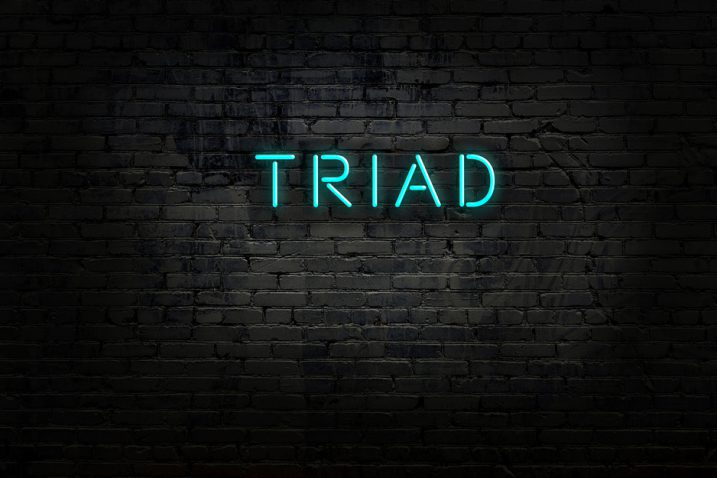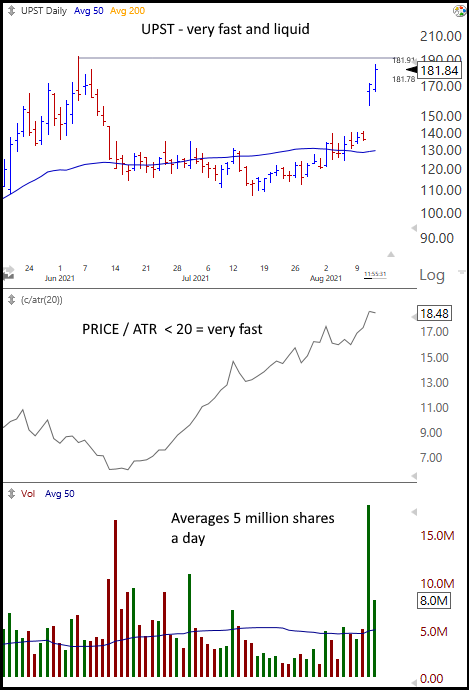Choosing stocks with bullish chart patterns is an obvious step towards profitable trading, but buying stocks that also have high volatility and liquidity is a simple way to substantially boost your profits. Here’s how the Triad of Trading Profits helps ensure your stock picks always give you maximum “bang for the buck.”
When scanning for new swing trade setups in our nightly stock report, we look for bullish chart patterns with potential for explosive rallies in leading growth stocks.
However, we do not automatically target a stock for buy entry just because it has a bullish chart pattern.
In addition to assessing overall market conditions, we must also determine if every potential stock trade also has the proper amount of volatility and liquidity.
Continue reading to discover how to consistently choose only the best stocks with ample volatility, liquidity, and reliable chart patterns–the “triad of trading profits” that will set you on the path to consistent, long-term trading success.
Aiming for the perfect balance
In our style of short to intermediate-term stock trading, we first look to trade with the prevailing market trend (typically in the same direction of the 50-day moving average).
When the market is trending higher, we focus on exposing our capital to as many bullish situations and trade setups as possible, in order to maximize trading profits.
In order to do so, we typically target leading growth stocks that are volatile enough to produce gains of at least 20-40% in a short period of time.
Our typical holding period of several weeks enables us to maintain consistent portfolio rotation, which again aids in maximizing trading profits.
Nevertheless, the process is not as simple as building a portfolio of the most volatile stocks in the market and letting the chips fall where they may.
Rather, the goal is finding the best stocks to buy (in a bullish market) that provide the perfect balance between volatility, liquidity, and reliable chart patterns.

Finding the perfect triad of trading profits
Scanning for stocks with the winning triad of volatility, liquidity, and reliable chart patterns is actually easier than it may sound. Here’s how to do it.
Volatility
To determine the true volatility of a stock, we use a simple and highly effective formula known as the Price/ATR Ratio.
We start by using an online trading platform such as TradeStation or Interactive Brokers, then set the stock chart to display the ATR (Average True Range) indicator.
ATR is an objective, technical measurement of a stock’s volatility, and is calculated as the greatest of the following:
- current intraday high less the current intraday low
- the absolute value of the current high, less the previous closing price
- the absolute value of the current low, less the previous closing price
Based on the formula above, ATR simply measures the average intraday trading range of a stock.
We specifically use a 40-day ATR, which tells us the average daily volatility of a stock, averaged over the past 40 days (20-day ATR also works well).
Since higher priced stocks automatically have a greater trading range due of their high prices, we do one final calculation to balance out this effect.
This final step is to simply divide the last price of a stock by its 40-day ATR (Average True Range).
Example:
- $40 stock that has a 2-point ATR
- $40/2 = 20
- Stock trades at 20 times its ATR
Likewise, a $40 stock with a 1-point ATR is trading at 40 times its ATR ($40/1).
With this ratio, a lower number indicates a more volatile stock than a higher number (which is better for our style of momentum swing trading).
When dividing the stock price by its ATR, you will see that most stocks fall in the 20-40 range.
Note that we only apply this ratio (stock price/ATR) to stocks trading above their 50 and 200-day moving averages.
Stocks in a downtrend will usually have lower readings, which is typically due to the high volatility of sell-offs (these stocks are not included in our scans).
We prefer to trade stocks with a Price/ATR ratio of 20-30.
A stock with a ratio above 50 is a bit too slow and more than likely will struggle to produce an explosive move in a short period of time.
Conversely, a stock with a Price/ATR Ratio below 20 means the stock is quite volatile, a bucking bronco and possibly tough to ride. Though very rewarding if one can spot lower-risk entry points.
Liquidity
The second component of the triad is focusing on stocks that have sufficient liquidity for short-term trading.
In the Model Portfolio of our Wagner Daily report, we target stocks with a minimum average daily volume of at least 250,000 shares–but 1 million or more is ideal.
We also prefer trading higher-priced stocks, as they allow institutional funds to more easily maneuver in and out of trades without significantly affecting the prices.
If you’re a trading with a smaller account, it’s important to understand that you should never avoid trading an expensive stock due to its high price alone (this post explains why).
The combination of a liquid, high-priced, and fast-moving stock can produce explosive gains.
Reliable Chart Patterns
Our rules for Volatility and Liquidity are objective, but the final piece of the triad is more subjective–finding good-looking charts that can produce low-risk, reliable buy entry points.
Fast-moving stocks require low-risk entry points, which allow us to minimize risk and maximize the reward to risk ratio for each new swing trade entry.
Of course, there are thousands of different chart patterns that can be effective, but we keep it simple by buying base breakouts and pullbacks after the breakouts.
Our strategy page provides you with a helpful overview of the types of patterns we typically trade.
We also review top chart patterns and winning trade setups with our members every day in Swing Trader Chat–-a fantastic resource for newer traders looking for a proven, winning edge.
Liquid Movers
Below are two examples of the type of stocks that meet our ideal criteria for Volatility and Liquidity.
Both stocks have a Price/ATR ratio near the 20 level, which means they are fast movers.
With millions of shares changing hands every day, both stocks are also highly liquid.
Advanced Micro Devices ($AMD)
Upstart Holdings ($UPST)
Liquid movers, like the two stocks above, are the types of stocks we prefer to trade.
However, low-risk trade setups in liquid movers may sometimes be challenging to find (depending on the market cycle).
When this happens, we occasionally shift our focus to slower moving stocks with higher Price/ATR ratios–typically over 50.
Still, we usually pass on trade setups with a Price/ATR ratio over 50 when market conditions are fine.
Finally, please note that the fastest-moving stocks on a watchlist are not automatically the best trade setups!
Liquid movers can sometimes be challenging to trade–particularly if you’re new to trading and do not yet have a rule-based system like we employ in our swing trading report.
Always stick to your system, focus on low-risk entries, and do not chase a runaway mover if you missed the proper buy entry point.
Maximizing your potential trading profits
Unless you have the luxury of trading an account with virtually unlimited funds, it is crucial to only trade stocks that potentially provide you with the most “bang for the buck” (greatest opportunity for maximum profits when they take off).
There may be hundreds of stocks with nice-looking chart patterns in a typical bull market, but get in the habit of always checking for ample Volatility (Price/ATR ratio) and Liquidity before placing a trade.
Filtering out stocks with low volatility and/or liquidity is an excellent way to narrow down your watchlist if you’re in a market with too many bullish chart patterns to consider.
If you prefer us to do the “heavy lifting” of scanning hundreds of chart patterns every day, we’ve got you covered!
Get started now with your Wagner Daily membership and see why thousands of traders since 2002 have learned to profit from our proven, winning trading strategy.




Deron, I use 20-day ATR and am wondering how you came up with 40-day? Thanks
Hi Andy,
It does not make much of a difference which period one uses for ATR, just as long as you are consistent.
For me personally, I like the 40-day ATR because the longer period helps to give a more accurate representation of a stock’s volatility, whereas a shorter period is more susceptible to skewing by short-term news events.